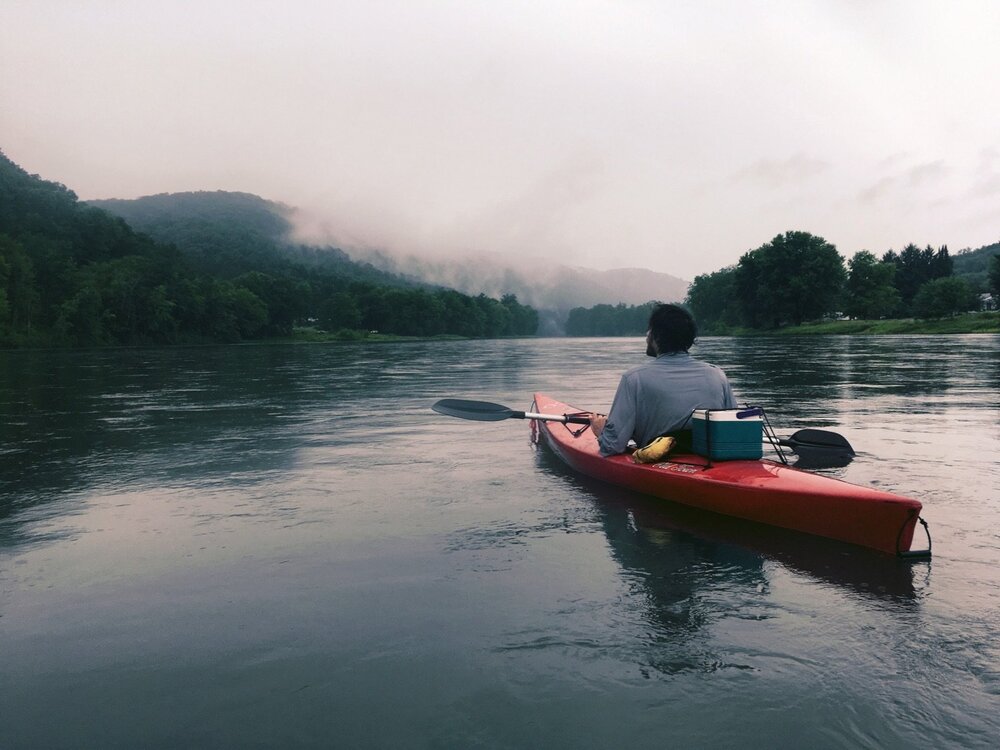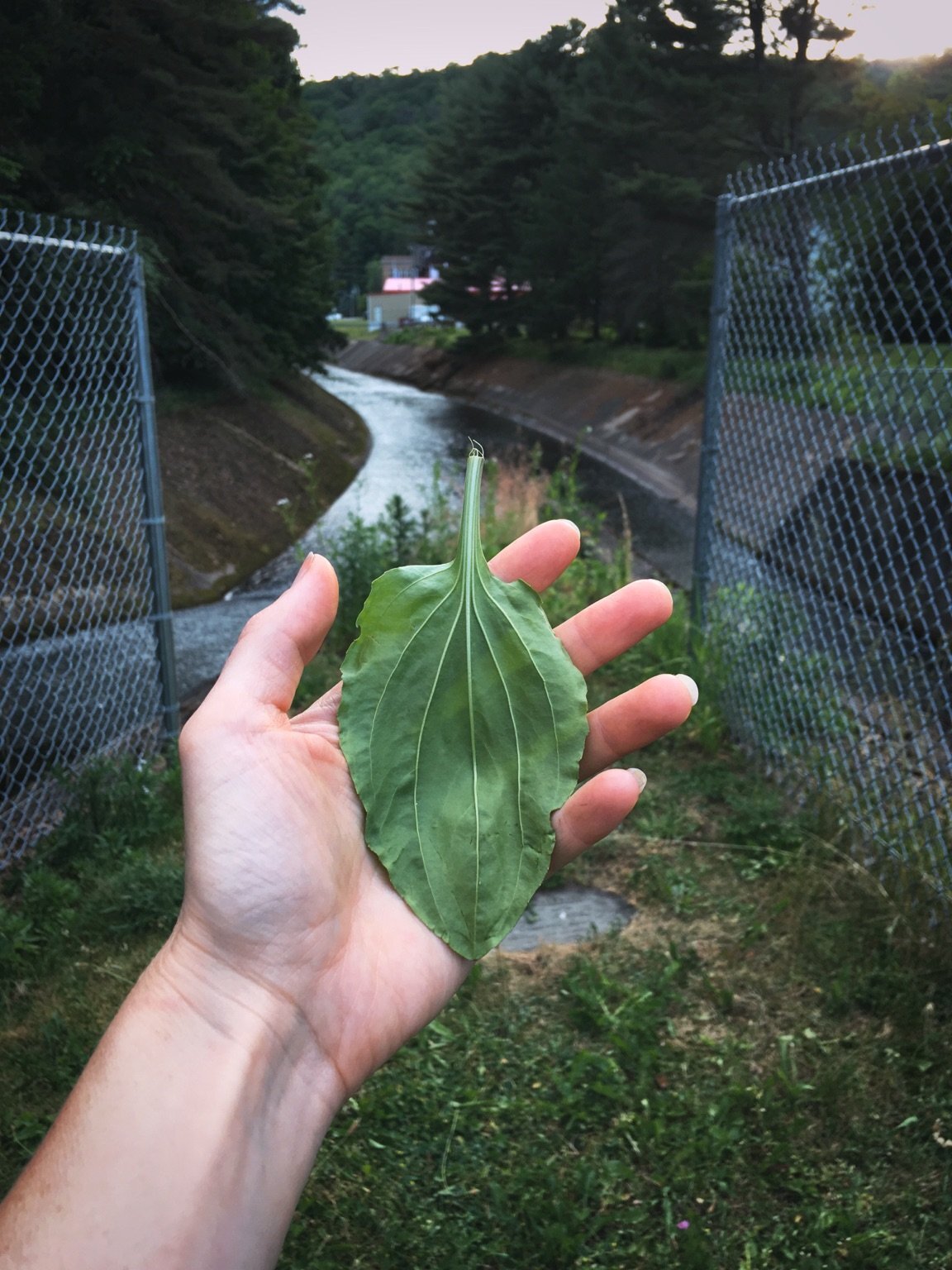
Rain on a River’s Face
The Ohio River is the most polluted river in the United States. In this series of essays entitled ‘The Ohio River Speaks,‘ Will Falk travels the length of the river and tells her story. Read the first, second, third, fourth, fifth, sixth, seventh and eighth part of Will’s journey.
As the bow of my kayak slid into the Ohio River at the Buckaloons Recreation Area boat launch, on a cloudy morning in late July, all I wanted was a quiet mind. I was full of an anxious, noisy din produced by several sources.
After eight weeks of listening to and writing about the Ohio River, the stories the river was telling me – stories about mass extinction, the practice of scalping, and massacres – were emotionally exhausting. Meanwhile, national news was generally terrifying. COVID-19 surged while many humans believed the pandemic was a conspiracy designed to restrict their personal freedoms. Police brutalized citizens protesting police brutality. Reports from cities including Portland and New York described federal agents arbitrarily grabbing citizens off the streets and detaining them in unmarked vehicles. And, president Donald Trump, trailing Joe Biden in the polls, floated the idea of suspending the presidential election for the first time in American history.
I was also running out of the money I saved up to travel with the Ohio River. I spent a week and a half with my head buried in a computer screen while I created and shared an online fundraiser. Guilt accompanied my request for money. I felt guilty for not saving enough money. I felt guilty for not using my money more efficiently. Then, I felt guilty for feeling guilty because I wondered if the Ohio River thought my guilt in requesting money for her suggested I didn’t think she was worth requesting money for. To top this cup of self-loathing I brewed for myself off, I also felt guilty for spending time creating an online fundraiser when I could have been listening to the river.
My journey with the Ohio River was taking much longer than I originally planned for. I knew the Ohio River could speak. But, I was unprepared for how much she had to say. In eight weeks, I had only traveled the first third of the first third of the Ohio River, the part most commonly known as the upper Allegheny. Her answers to my two questions – “Who are you? And, what do you need?” – were rushing past me in a torrent profoundly more powerful than the proverbial firehose.
There were topics I sensed she still wanted me to write about before moving on. Truck engines hauling radioactive fracking wastewater throughout northern Pennsylvania and the ubiquity of their screeching brakes whined for me to investigate how dangerous that wastewater truly is. Pennsylvanians’ proper sense of pride in the dwindling, clean streams that still run through the state conflicted with Pennsylvanians’ misplaced pride in the role the state played in America’s first oil boom. The iron taste these conflicting prides left in my mouth wouldn’t wash out no matter how hard I tried to spit it out.
Black and white photographs in county historical society buildings haunted me. They showed hundreds of logs, the corpses of towering trees, floating down the Ohio River. They showed the eerie, bare hillsides those trees were stolen from. When I saw these photos, I felt the agony and anger the Ohio River still carries for being used to haul her forest friends, the old growth white pines and hemlocks that once grew along her banks, away. Once I felt this agony and anger, ghosts climbed from the shadowy photographs and cried out for attention.
Competing voices in my head struggled to be heard. One voice said, “Quick look away. Forget you saw it.” Another voice screamed angry obscenities. One voice asked, “Where’s my beer? Where’s my weed? What’s on Netflix?” My constant companion, the unwelcome guest in my head, the one who always tells me my writing sucks, acquired a bullhorn somewhere and was testing its volume against my ear drum. I despaired and thought maybe he was right that I had neither the time nor the talent to tell these stories adequately.
A few minutes before I pushed my kayak in the water, I saw a sign posted on the door to the Buckaloons men’s restroom. The sign warned visitors that “WE are STILL IN A PANDEMIC” before asking restroom users to keep the area clean and to adhere to social distancing. The sign concluded with: “We know that this place feels different, and it is! It can be a nice change of pace from the world; please help us keep it open.”
The realities underlying the sign’s rhetoric frustrated me. I knew the reason “that this place feels different” is because relatively undeveloped sections of rivers like the one at Buckaloons are becoming more and more rare. The reason a place like Buckaloons “can be a nice change of pace from the world” is because, for most people, “the world” is primarily human. “The world” is an office, a city block, a suburban house. “The world” exists online and onscreen, in headsets and TV sets. “The world” is no longer forests, rivers, mountains, and seas. The real world has become “a nice change of pace.”
***
Noise carries over water. And, just a few minutes after I pushed my kayak into the water, a family of nearby canoers began blaring Kenny Chesney from portable speakers. Someone asked the woman in charge of the music, “You like country music, huh?” And, the woman responded, “Yeah, there’s a time and a place for it.” I suppressed an urge to tell her this was neither the time nor the place.
Melissa Troutman accompanied me again. She graciously offered me one of her family’s kayaks and help with shuttling vehicles between the put-in at Buckaloons and the take-out fourteen miles away at the Bonnie Brae boat launch, just outside of Tidioute, PA. We originally planned to float about three miles down to Thompson’s Island where we would spend the day and camp for the night. We would float the remaining eleven miles the next day.
I was excited about Thompson’s Island because the island is home to some of Pennsylvania’s last remaining old growth forests. These forests were protected from the loggers by the relative inaccessibility posed by the Ohio River surrounding the island. But, when we stopped on the island, the skies darkened and the clouds released a downpour.
The noise in my mind must have been so loud while I was preparing for the trip that I neglected to listen to the voice that suggested I bring rain gear on a day the weather services virtually guaranteed would rain. In addition to ignoring the need for rain gear, I left my phone in my car. Melissa, fortunately, had hers and checked the weather. Thunder storms were approaching and would likely last well into the next day. Not wanting to chance lightning while on the water, we decided to hustle the eleven miles down to the takeout. As our plans turned from a leisurely day resting on a beautiful island into a long day of paddling in a rainstorm, the noise’s volume increased.
Back in our boats, I was disappointed to find that houses and even a few mansions were built along much, if not most, of our route, despite the fact that it ran through the Allegheny National Forest. I had heard that this section of the river was one of the most well-preserved sections of the Ohio River basin. That may be, but my definition of “well-preserved” was different from what I found between Buckaloons and Tidioute.
There was beauty. I saw my first green heron. And, then my second and third. The last two looked like brothers with the big brother constantly running away from the little brother who really wanted to play. The joy I felt in seeing these green herons was undermined by my fear that encroaching development for vacation homes and fishing lodges would destroy the herons’ nesting grounds.
I saw half a dozen or so bald eagles. I even saw one make a successful dive for a fish. But, I soon lost myself pitying bald eagles for being chosen as the mascot for the American Empire. I hoped no one in the future would blame bald eagles for the sins of a nation they never asked to represent.
A couple of hungry ducks followed Melissa and I around for half a mile, quacking at us for food. Melissa gave them some bread and I wondered out loud whether diets high in carbohydrates could give ducks diabetes like those diets do to humans. When I saw a great blue heron silhouetted against invasive knotweed, I worried about the plants the knotweed was crowding out instead of admiring the heron’s legendary grace.
As the mental noise intensified, I began to ask myself: What sort of neurosis prevents a person from enjoying the sight of playful green herons? What kind of person worries that tossing ducks a few bites of bread would give them diabetes? Why can’t I silence this angst and simply enjoy the trip?
I thought about asking the Ohio River for help. But, each time I considered asking, I shot the idea down, chiding myself that the journey was about the river’s needs, not mine. Regardless, with a mile left to go and my surgically repaired shoulders screaming with every paddle stroke, the Ohio River gave me what I longed for.
I don’t know how she knew what I needed. Maybe her intuition is so strong she hears thoughts and emotions like humans hear the spoken word. I was paddling hard and sweating. Maybe the water forming my sweat rolled off my skin, fell into the river, and shared my secrets with her.
I sat in a strong current, resting with my paddle across the kayak’s bulkhead. I let the river do the work of pulling me to the dry warmth of my Jeep parked at the take-out. My physical weariness tuckered out the petulant voices in my head. I heard the rain falling on the Ohio River’s face. The infinite sound of individual rain drops joining the river in a communion of life-giving water created a murmur. The river and the rain hummed softly. A whisper shimmered in the air. The Ohio River said, “Shhh, shhhhh, shhhhhhhh.”
Then, a dark, majestic shape lit from a white pine branch hanging no more than twenty yards above my head. A golden eagle! She flew a wide arc over the water. And, as she turned upstream, another golden eagle lifted into the sky from another branch to join her. Their wings pulled the noise away from me. As the golden eagles disappeared in the distance, the Ohio River whispered, once again, “Shhhhh.”
And, my mind was quiet.

![[The Ohio River Speaks] Everyday Ecocide and Garden-Variety Genocide](https://dgrnewsservice.org/wp-content/uploads/sites/18/2020/06/Everyday-Ecocide-and-Garden-Variety-Genocide.jpg)
